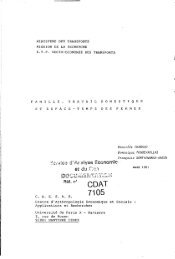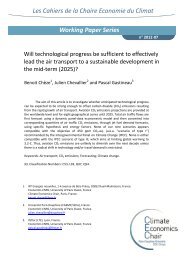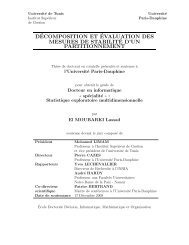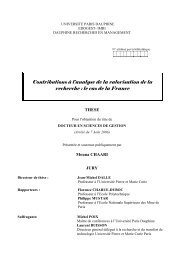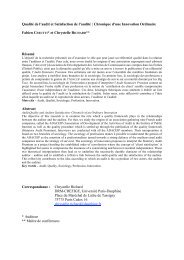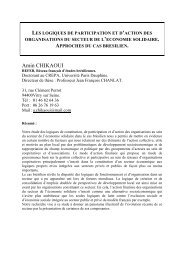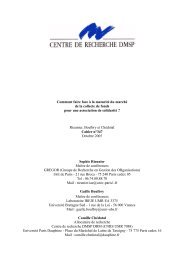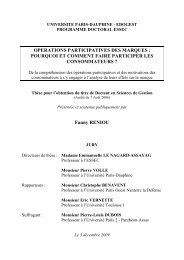TH`ESE Docteur de l'Université Paris-Dauphine Morgan HERVÉ ...
TH`ESE Docteur de l'Université Paris-Dauphine Morgan HERVÉ ...
TH`ESE Docteur de l'Université Paris-Dauphine Morgan HERVÉ ...
You also want an ePaper? Increase the reach of your titles
YUMPU automatically turns print PDFs into web optimized ePapers that Google loves.
The EU ETS is a cap-and-tra<strong>de</strong> policy. A cap-and-tra<strong>de</strong> scheme gives the<br />
incentive to reduce emissions beyond the cap since compliance-buyers are<br />
allowed to sell emissions rights in excess of their emissions needs to those<br />
for whom it is more expensive to reduce their emissions on their own. The<br />
asset tra<strong>de</strong>d is the European Union Allowance (EUA) which gives the right<br />
for its EU ETS hol<strong>de</strong>r to emit one ton of CO2 in the atmosphere. To claim<br />
compliance, EU ETS installations must surren<strong>de</strong>r as many EUAs as tons<br />
of CO2 they have emitted over a given year. They can do so by either acquiring<br />
more EUAs (or similar assets) or by reducing their emissions. The<br />
need for trading happens because of the pre-established scarcity of emissions<br />
rights over a given period of time - the cap suggested by European member<br />
states and accepted by the EC. The allocation of allowances in the EU ETS<br />
among the trading sectors recognizes different sectoral abatement options<br />
and related costs as well as impacts on competitiveness.<br />
At the time of writing, there were three compliance periods in the EU ETS:<br />
the trial phase (phase I) between 2005 and 2007, the Kyoto phase (phase<br />
II) between 2008 and 2012 and the post-Kyoto phase (phase III) between<br />
2013 and 2020. The trial-and-error policy process brought many changes<br />
and adjustments to the policy over these three phases.<br />
1.1.2 EU ETS Phase I: a trial phase<br />
The modus operandi common to phase I and II of the EU ETS is the following.<br />
EU member states i<strong>de</strong>ntify the installations falling within the scope of<br />
the directive: stationary sources of carbon dioxi<strong>de</strong> (CO2) emissions with a<br />
capacity above 20 MW. EU member states then enter in consultation with<br />
the owners of the regulated installations to obtain historical emissions data<br />
or attempt to do so based on various estimation approaches. Each member<br />
state applies its effort share of the bur<strong>de</strong>n sharing agreement to its national<br />
emissions cap and distributes this bur<strong>de</strong>n among the installations. As a result,<br />
an emissions cap, corresponding to the maximum quantity of CO2 an<br />
installation can emit during a given period, is set. The next step involves<br />
drafting a document called a national allocation plan (NAP in short). This<br />
document summarises elements from the whole process and ultimately outlines<br />
the overall national emissions cap and each installation’s emissions cap<br />
over an entire market phase. The NAP is then communicated to the EC.<br />
The EC reviews the submission to ensure that (1) the member state is on<br />
the right track to meet its emissions reduction objective and (2) that ultimately<br />
the EU is expected to claim compliance towards Kyoto.<br />
Stationary sources falling within the scope of the Directive are combustion<br />
installations with an installed capacity superior to 20 MW. Some 70% of<br />
those installations are either producing power or heat and it was estimated<br />
10



